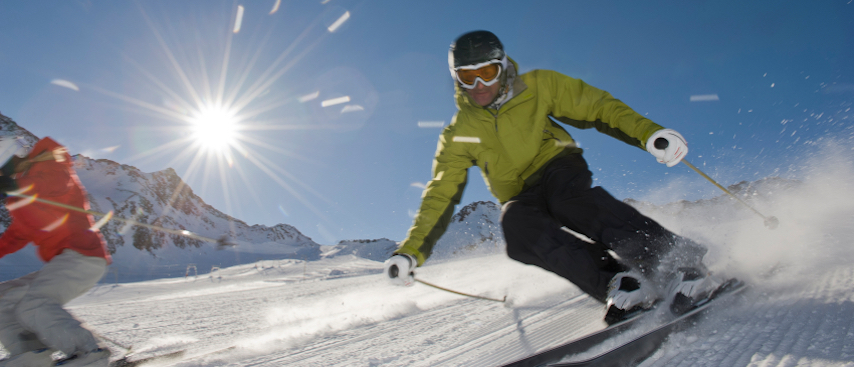The Chamonix Valley, in the north-west corner of the French Alps, is home to Mont Blanc (4,810 m) — the highest peak in Western Europe. This mighty mountain dominates both the skyline and the local climate, shaping the Chamonix weather throughout the year.
The town of Chamonix-Mont-Blanc itself sits at around 1,035 m above sea level, surrounded by glaciers, alpine forests and dramatic peaks that rise more than 3,000 metres higher.
Introduction to Chamonix weather
The Chamonix Valley enjoys four distinct seasons, each offering its own charm and reason to visit. It’s one of the things that makes Chamonix weather so unique — and why many visitors return year after year to experience the mountains in every mood.
Spring in Chamonix is bright and fresh, as the valley begins to thaw and temperatures climb. Snow often lingers on the high peaks well into the warmer months, creating a stunning contrast between green meadows and white summits.
Summer brings warm, sometimes hot days, perfect for hiking, biking and climbing. Dramatic afternoon storms are common and help to cool things down before the evening.
Autumn is a peaceful season with golden forests, crisp air and quieter trails. As temperatures drop, the snowline gradually descends, signalling that winter is on its way.
Winter transforms Chamonix into a snow-covered paradise, with flakes often reaching the town centre. Daytime temperatures typically range from 2–7°C, creating ideal conditions for skiing, snowboarding and cosy après-ski.
Thanks to its alpine setting, Chamonix’s mountain climate is generally cooler and wetter than the French national average. The surrounding peaks create their own microclimates, meaning conditions can change quickly — sometimes several times in a single day.
In winter, most of that precipitation falls as snow, blanketing the valley and ski areas. The town centre and valley floor stay cool for much of the day since the sun sits lower in the sky, offering less direct warmth. Meanwhile, south-facing slopes can feel noticeably warmer when the sun is out and the wind is calm. This temperature contrast happens because cold air sinks to the bottom of the valley, while lighter, warmer air gathers higher up on the slopes.
During summer, Chamonix enjoys warm, often hot days, with temperatures in the valley regularly reaching 25–30°C. It’s cooler at higher altitudes, so if you’re heading up the mountains — for example to the Aiguille du Midi — be sure to bring an extra layer.
This mix of crisp alpine air and strong sunshine makes Chamonix an exciting destination year-round, whether you’re skiing in deep winter or hiking under blue summer skies.

Summer in Chamonix often brings dramatic mountain thunderstorms — one of the most spectacular sights the valley has to offer. These storms usually build up in the late afternoon after hot, sunny days, creating an unforgettable display over the peaks.
From the comfort of your accommodation, you can watch dark clouds roll in from one end of the valley before the sky lights up with flashes of lightning against the backdrop of Mont Blanc. It’s a reminder of how powerful and ever-changing the Chamonix weather can be — and part of what makes summers here so unique.
What causes summer mountain thunderstorms?
During the warmer months, Chamonix summer weather is often punctuated by short but powerful mountain thunderstorms — a dramatic reminder of how dynamic the alpine climate can be. These storms tend to form in the afternoon, bringing a welcome burst of cooler air after hot, sunny mornings.
Thunderstorms develop when warm, moist air meets cold, dry air. The warm air rises, cools, and condenses into clouds. As particles within the clouds collide, they build up electrical charges — and when that energy is released, we see lightning. The accompanying thunder is the sound of that lightning rapidly heating the air around it, creating vibrations that echo through the valley.
Sun and UV Protection at Altitude
Whether it’s summer or winter, don’t be fooled by the cooler mountain air — UV radiation in Chamonix is significantly stronger at altitude. Exposure increases by about 4–5% for every 300 m gained, meaning the higher you go, the greater the risk of sunburn and snow blindness.
Always wear high-factor sun cream and quality UV-protection sunglasses, even on cloudy days. Snow and ice also reflect sunlight, effectively doubling your exposure — so sun protection is essential year-round.
How Mont Blanc Influences Chamonix Weather
Towering over the valley at 4,810 m, Mont Blanc has a huge influence on the Chamonix weather system. Acting as a natural barrier, it can create distinct conditions on either side of the massif. For example, while Chamonix may be cloudy, Courmayeur — just through the Mont Blanc Tunnel — might be basking in sunshine.
This contrast is part of what makes the region so special: whether you’re chasing good weather or fresh snow, a quick trip over the border often changes everything. And if you’re visiting in winter, the Mont Blanc Unlimited ski pass lets you take advantage of that — with access to resorts in France, Italy, and Switzerland.
Chamonix weather month-by-month
The below information on Chamonix weather is intended as a guide only, to give you an idea of what to expect. It is based on previous weather conditions, our own experience and anecdotal information but is not a substitute for accurate Chamonix weather forecasts – see below for our recommendations of where to find more information.
December – December announces the start of the winter season with the snow line getting lower and ski areas opening. The snow cover varies from year to year but there’s often a good build-up all the way down to town by Christmas. Cold temperatures mean that, even if the snow levels are not built up yet, the snow cannons can be working to make sure that the resort is ready to open for the start of the winter season.
January – January is usually a great month for snow, with cold temperatures ensuring that the snow that does fall sticks around. It can get chilly on the chairlifts so you’ll be glad of your helmet or a good hat, however the cold keeps the snow in great condition so you’ll be able to enjoy some great snow on quiet pistes, once the rush of New Year is over.

February – the Chamonix weather starts to warm up a little in February as we welcome families on their school holidays. However the snow also keeps falling so that ski conditions are great and the depth of snow on the mountain keeps increasing, meaning that off-piste runs like the Vallée Blanche become more accessible too.
March – as the school holidays finish, it’s a good opportunity to catch some early spring skiing, with the days getting longer and the sun getting warmer in the sky. The snow depths are still good too, with snowfall still expected to top up the existing base.
April – Easter holidays mean that families are back in Chamonix in April, making the most of more spring skiing on the mountains as well as opportunities for sunbathing and enjoying the spring flowers which start budding in the valley floor.
May – the last day of the ski season is usually the first Sunday in May, when Les Grands Montets will host a raucous closing party! Snow will linger at high altitude but trails along the valley floor and lower altitudes will be enjoyable for walking or biking. Days are likely to be warm, but evenings will feel cool after the sun sets.
June – June continues to get warmer, melting snow on the higher walking trails, but snow can stick around well into July so it’s always best to check the latest conditions with the High Mountain Office before heading out. From June, you can start enjoying the summer activities on offer – from climbing to water rafting – as the conditions improve and before the town becomes busier with summer visitors.
July – the Chamonix weather will be warm or hot in July, often building up into sultry afternoons and evening thunderstorms. All of the summer activities are possible at this time of year, and rafting or canyoning are the ideal ways to cool off!
August – August is similar to July, though perhaps even a little hotter in the middle of the day. The town is also busy, so we recommend getting some altitude for fresher air and to escape the clouds.
September – once the busy summer season has passed, September is a beautiful month. The town centre is quieter but the Chamonix weather often stays beautiful, making it a great time for biking and climbing, as well as enjoying end-of-summer walks with many of them still accessible on the lift system.
October – the autumn colours really come into their own in October, with the trees turning all shades of gold, yellow and red. The Chamonix weather is likely to be cooling down, perhaps with some rain fall too, but it won’t usually be cold enough for snow yet.
November – the end of autumn can still offer some lovely days, and as the mercury drops further snow may start falling at altitude. If snow conditions are really good, the higher slopes at Les Grands Montets may open at weekends at the end of November, though more often this happens in early December.
Webcams for Chamonix
While webcams aren’t a substitute for a detailed Chamonix weather forecast, they’re perfect for a quick, real-time look at the current conditions before you head out. Whether you’re planning to ski, hike, or simply enjoy a coffee with a view, a quick glance at the webcams will show you exactly what’s happening across the valley. Check live views and weather updates on our Chamonix webcam page.
Chamonix weather forecast
For the latest and most reliable Chamonix weather forecast, you can always check the live updates on our website. But if you’d like to add a touch of local tradition to your predictions, there are also a few time-tested methods passed down through generations of mountain dwellers.
Nature’s Clues: Reading the Seasons
According to old alpine wisdom, a heavy crop of red berries in autumn signals a cold and snowy winter ahead. There’s no real science behind this “red berry rule,” but locals still keep an eye on the trees each autumn — and it’s a fun way to guess what the coming season might bring. After all, long-range forecasts beyond two weeks are tricky in a place as dynamic as Chamonix!
“Mont Blanc’s Hat” — A Cloud with Meaning
One of the best-known weather signs in the Alps is “Mont Blanc’s hat.” When a cloud settles on the summit and begins to spread down the slopes, it usually means bad weather is on its way. This formation happens when humid air rises and condenses at high altitude, often signalling an incoming storm.
Local weather watchers add another layer to this:
“If it doesn’t reach the Verte, Mont Blanc won’t be disturbed.”
Or in French: “Si Verte ne veut, Mont Blanc ne peut.”
That means if the cloud doesn’t extend to the neighbouring Aiguille Verte (4,122 m), then Mont Blanc’s “hat” might just be a false alarm.
More about Chamonix weather
If you’d like to explore more detailed data and live updates, here are some useful links for checking the latest Chamonix weather and long-term climate information: Chamonix-meteo.com, Chamonet.com, Chamonix Tourist Office, Climate-Data.org.



